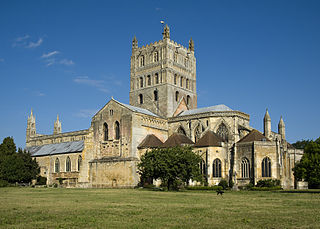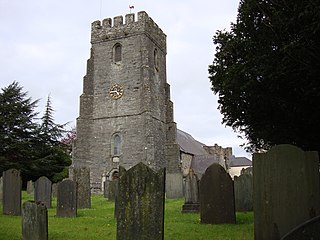Related Research Articles

The Abbey Church of St Mary the Virgin, Tewkesbury, commonly known as Tewkesbury Abbey, is located in the English county of Gloucestershire. A former Benedictine monastery, it is now a parish church. Considered one of the finest examples of Norman architecture in Britain, it has the largest Romanesque crossing tower in Europe.

Deerhurst is a village and civil parish in Gloucestershire, England, about 2 miles (3 km) southwest of Tewkesbury. The village is on the east bank of the River Severn. The parish includes the village of Apperley and the hamlet of Deerhurst Walton. The 2011 Census recorded the parish's population as 906, the majority of whom live in Apperley.

Wymondham Abbey is the Anglican parish church for the town of Wymondham in Norfolk, England.
Richard fitz Gilbert de Clare 3rd feudal baron of Clare in Suffolk, was an Anglo-Norman nobleman. A marcher lord in Wales, he was also the founder of Tonbridge Priory in Kent.

The Abbey of St Mary is Grade I listed ruined abbey in St Dogmaels in Pembrokeshire, Wales, on the banks of the River Teifi and close to Cardigan and Poppit Sands.

Durham College was a college of the University of Oxford, founded by the monks of Durham Priory in the late 13th century. It was closed at the dissolution of the monasteries in the mid 16th century, and its buildings were subsequently used to found Trinity College, Oxford.

Saint Padarn's Church is a parish church of the Church in Wales, and the largest mediaeval church in mid-Wales. It is at Llanbadarn Fawr, near Aberystwyth, in Ceredigion, Wales, United Kingdom.
This article is about the particular significance of the century 1101–1200 to Wales and its people.

The Priory Church of St Mary, Abergavenny is a parish church in the centre of Abergavenny in Monmouthshire, Wales.

Hatfield Broad Oak Priory, or Hatfield Regis Priory, is a former Benedictine priory in Hatfield Broad Oak, Essex, England. Founded by 1139, it was dissolved in 1536 as part of Henry VIII's dissolution of the monasteries.

Goldcliff Priory was a Benedictine monastery in Goldcliff, Newport, South Wales. It was established in 1113 by Robert de Chandos as a subsidiary house of the Abbey of Bec in Normandy. The priory was built on a coastal site, now the land of Hill Farm. In the 1950s, the Monmouthshire writer Hando noted the outlines of buildings visible as grass patterns or crop marks, but by the 1970s the only remaining structural element was part of a cellar in the farm house.

Leonard Stanley Priory was a priory in Gloucestershire, England. Over the years following the dissolution most of the buildings of the priory complex have been destroyed.

Pamber Priory is a Church of England parish church and former priory, then known as West Sherborne Priory or Monk Sherborne Priory, at Monk Sherborne in the English county of Hampshire.

St Mary Magdalene was a Benedictine priory in Lincoln, England. Along with Sandtoft Priory and Hanes Cell, it was a Lincolnshire cell of St Mary's Abbey in York, England. A surviving building, once owned by the priory, is Monks' Abbey, Lincoln.

Carrow Abbey is a former Benedictine priory in Bracondale, southeast Norwich, England. The village on the site used to be called Carrow and gives its name to Carrow Road, the football ground of Norwich F.C., located just metres to the north. Granted by charter of King Stephen, the abbey was founded ca. 1146, and became a Grade I listed building in 1954.

Pill Priory is a Tironian house founded near Milford Haven, Pembrokeshire, South West Wales in the late 12th century.

St Mary the Virgin's Church is a former priory church in the village of Bromfield, Shropshire, England. It is an active Anglican parish church in the deanery of Ludlow, the archdeaconry of Ludlow, and the diocese of Hereford. Its benefice is united with those of 5 other parishes to form the Bromfield Benefice. The church is recorded in the National Heritage List for England as a designated Grade I listed building.

St Mary's Church is an Anglican church located in Cardigan, Ceredigion, Wales. In 1428, with the disappearance of Holy Trinity Church, St Mary's formally became the parish church of Cardigan, but it continued to serve as a priory church until the Reformation, being located close to Cardigan Priory. It is a Grade II* listed building.
References
- 1 2 The Athenæum: a journal of literature, science, the fine arts, music, and the drama (Public domain ed.). J. Francis. 1906. pp. 476–. Retrieved 18 March 2012.
- 1 2 Pritchard, Emily M (1904). Cardigan Priory in the olden days (Public domain ed.). Heinemann. pp. 7, 15, 1 43, 44. Retrieved 18 March 2012.
- ↑ "The Priory". Coflein Database Record. Royal Commission on the Ancient and Historical Monuments of Wales . Retrieved 28 November 2016.
- ↑ Thomas, Thomas (1822). Memoirs of Owen Glendower, (Owain Glyndwr): with a sketch of the history of the ancient Britons, from the conquest of Wales by Edward the First, to the present time, illustrated with various notes, genealogical & topographical (Public domain ed.). Printed for the author (rector of Aberporth, Wales.) by J. Potter. pp. 198–. Retrieved 18 March 2012.
- ↑ "Cardigan Timeline". welshabbey.org.uk. Archived from the original on 24 December 2012. Retrieved 19 March 2012.
- ↑ Heale, Martin (2004). The dependent priories of medieval English monasteries. Boydell & Brewer. pp. 76–. ISBN 978-1-84383-054-2 . Retrieved 18 March 2012.